In Nova Scotia, you’re never more than 67 kilometres from the ocean. Thanks to endless pelagic adventures, from whale watching to dining at a restaurant on the ocean floor, this Maritime province has been dubbed Canada’s Ocean Playground. Proud Haligonians (Halifax locals) will tell you how much they love the fresh, salty sea breeze, the trendy arts and culture scene, and the distinct outdoor adventures of their city and province.
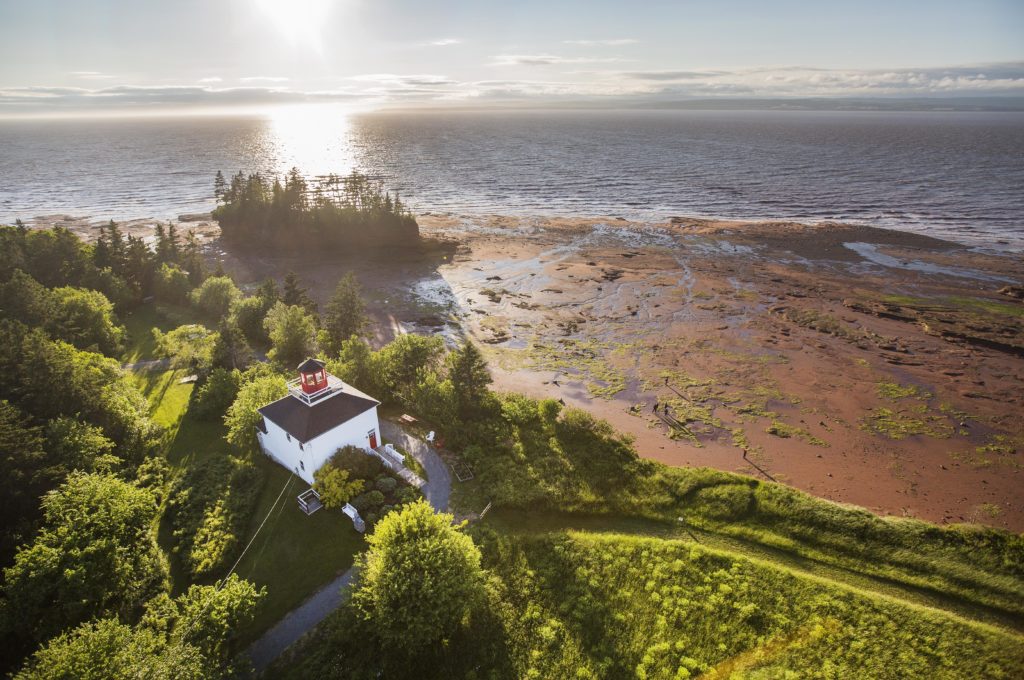
Twice each day the Bay of Fundy fills and empties its 160 billion tons of water creating the highest tides in the world (Photo: Burntcoat Head Park – Municipality of East Hants)
Whether you’re keen to try to the local cuisine, discover military history, or roam the beautiful outdoors, we’ve found an activity for you. Here are 20 unique things to do in Halifax and Nova Scotia.
1. Discover Canada’s unique Maritime cuisine
When a Canadian thinks of Nova Scotian cuisine, mussels, scallops, clams, and lobster are probably the first things that swim to mind. But when it comes to dishes that truly originated in Eastern Canada, locals will be more likely to mention rappie pie, a mix of potatoes and chicken; hodge podge, a combination of potatoes and vegetables lovingly cooked in cream in south shore homes; and the legendary Halifax donair. Nova Scotians take the donair seriously — invented in the 1970s, Haligonians stress that the donair is not a doner kebab or gyro. The proof is in the sauce: a creamy, garlicky sweet sauce slathered over spit-roasted shredded beef. Head to King of Donair (6420 Quinpool Rd) — the first in all of Canada and last you’ll ever need to try.

King of Donairs is a popular spot for late-night eats (Photo: Applehead)
2. Be a soldier for a day at Citadel Hill
Halifax, as a major port city on the sea, has long been a site for strategic military defense. Four forts have occupied the hilltop overlooking the harbour and downtown since 1748. The current Citadel, officially named Fort George, dates back to 1856 and features a distinctive star shape typical of British forts from the era. Walk the ramparts and learn about Halifax’s role in various wars, from the American Revolution to World Wars I and II. A visit at noon gives you the opportunity to see reenactors fire the traditional noon gun and sentry changes. The Citadel also offers a Soldier for a Day program, where you can don a uniform, learn to drill, and fire a rifle — Glengarry bonnet included.
5425 Sackville Street, B3J 3Y3
3. Visit one of the oldest breweries in North America
Alexander Keith trained as a brewer in Edinburgh and London before immigrating to Canada in 1817. Today, the Alexander Keith’s Brewery is nearly 200 years old, making it one of the oldest surviving breweries on the continent. Learn more about the history and brewing techniques of the beloved Canadian ‘Keith’s’ beer on a guided tour led by actors in period costumes. The tours wrap up at the Red Stag Tavern, the historic pub and cavern. They serve up small batch beers inspired by local Nova Scotian culture and limited-edition brews, all to the sounds live music from talented local artists.
1496 Lower Water Street, B3J 3R5
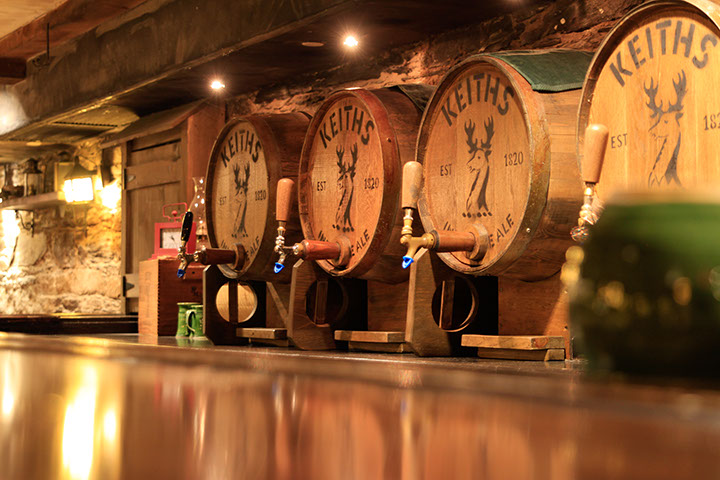
Kegs at the Stag’s Head pub (Photo: Alexander Keith’s Brewery_
4. Learn the history of Canada’s Black Loyalists
If you’ve read Lawrence Hill’s award-winning novel Book of Negroes (or seen the television series), you will have heard of Africville, Nova Scotia. This neighbourhood was where Black Loyalists (slaves and free Blacks who remained loyal to the British Crown during the American Revolution) were moved here at the end of the war. While the town itself was torn down in the mid-1960s, descendants and their history remain. In the northeast corner of Halifax is the Africville Museum (5795 Africville Rd), while in the downtown core is the Camp Hill Cemetery (1600 Summer St), the final resting place of Viola Desmond whose civil disobedience challenged racial segregation in Canada. For more on Nova Scotia’s Black history, head to the Black Loyalist Heritage Centre (119 Old Birchtown Road) in Shelburne. The Centre tells the story of the first free Black settlers, which by the late 1700s had grown to the largest settlement of free Black people outside of Africa.

Mural by Jarus in Mulgrave Park, Halifax (Photo: Fred via Flickr)
5. Get to know the inventor of the telephone, Alexander Graham Bell
Go back to the analogue age with a trip to the Alexander Graham Bell National Historic Site, the 25-acre property in Cape Breton overlooking the Bras d’Or Lakes. The museum features displays about the inventor, his inventions and innovations like telegraphs, phones, kites, and seaplanes, as well as the work he did in his summer home. Much of the artifacts and documents were donated from his estate across the bay in Beinn Bhreagh, where Bell is buried, making it the only museum in the world with pieces from his time in Baddeck.
559 Chebucto Street, B0E 1B0
6. Take a peek into Canada’s immigration history at Pier 21
The Canadian Museum of Immigration at Pier 21 is to Canadians what Ellis Island is to Americans, meaning it’s deeply embedded in Canada’s identity as a cultural mosaic. More than a million immigrants and refugees arrived in Canada via Pier 21 from 1928 to 1971, earning it the name ‘The Gateway to Canada’. The museum features temporary and permanent exhibits detailing what it was like to arrive in Canada at Pier 21 and how newcomers continue to contribute to Canada’s culture, economy, and way of life.
1055 Marginal Road, B3H 4P7

Exhibits at Pier 21 (Photo: Canadian Museum of Immigration at Pier 21)
7. Eat a meal on the floor of the Atlantic Ocean at Burntcoat Head Park
There aren’t many opportunities to walk along the bottom of ocean while staying dry, but thanks to Nova Scotia’s dramatic tide fluctuations, this is one of the them. Head to Burntcoat Head Park to see fossils and marine life lying on the ocean floor during low tide, when the ocean clears out baring the ocean’s rocky floor. Six days per year, the Flying Apron Inn & Cookery offers an extra special food tour and dining experience on the Bay of Fundy tidal flats. In the day, you’ll learn about local edible plants from a foraging expert followed by a seafood lunch atop the red rock cliffs; in the evening, you’ll enjoy a three-course dinner and campfire at their ocean floor restaurant.
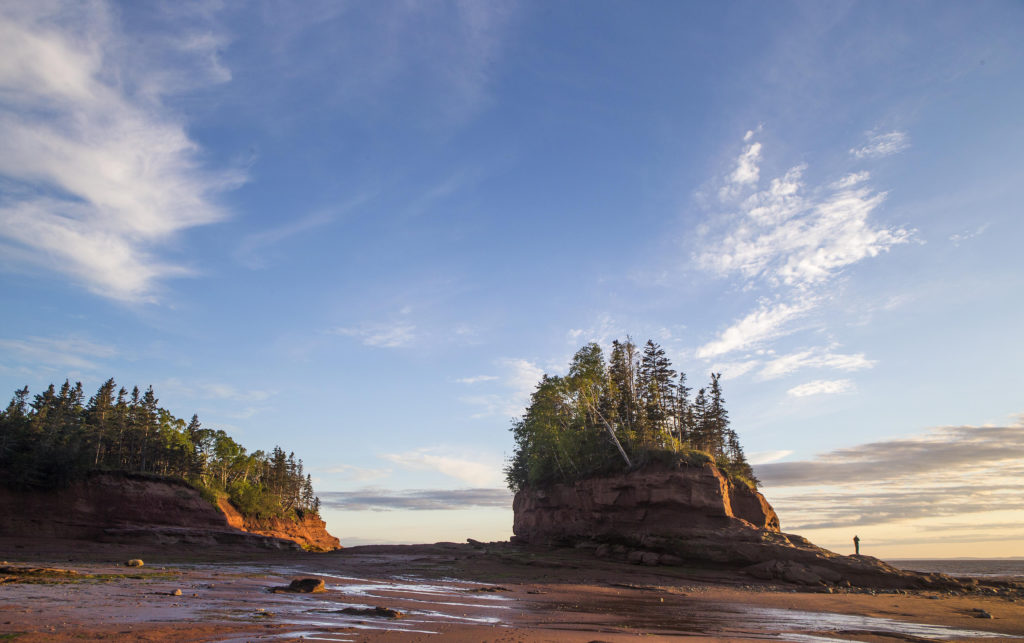
High tide at Burncoat Head Park (Photo: Burntcoat Head Park – Municipality of East Hants)
8. Walk along one of the longest boardwalks in the world
The Halifax boardwalk lays claim to the title of longest continuous boardwalk in the world. But the wooden walkway is more than just a path along the waterfront, it’s a gathering place for people from all over the city. Bask in the fresh maritime air while you saunter three kilometres of grand ships at dock, local kitsch shops, historic buildings, and seaside restaurants selling rum cakes and seafood. It’s a picturesque spot for a sunset walk or an afternoon stroll along the sea.
9. Explore Canada’s newest wine destination
Halifax may be known for beer, but Nova Scotia will soon be known for wine in Annapolis Valley. There are 11 established wineries and vineyards producing unique grape varietals like L’Acadie Blanc and Marechal Foch alongside the more familiar types like Pinot Gris and Riesling. Annapolis Valley is in the western part of the province along the Bay of Fundy, and its climate and location is key to the distinct reds, whites, and ice wines being produced. Drive responsibly around the Annapolis Valley or embark on a bus tour around the region to learn about Canada’s up-and-coming wine region.

Annapolis Valley is Canada’s up and coming wine region (Photo: Tourism Nova Scotia)
10. Stumble across the grave of J. Dawson, passenger of the Titanic
We can all thank James Cameron for bringing the tragic story of the RMS Titanic to life in his blockbuster film Titanic (1997). What this dramatization did not show was that the Nova Scotian city of Halifax was charged with burying and repatriating the bodies of the dead. While many victims of the disaster were buried at sea, 121 — many of whom remain unidentified — were interred at Fairview Lawn Cemetery. The area for Titanic victims is clearly marked and most received small black granite headstones engraved with notorious date of their passing: April 15, 1912.
11. Go on a clam digging adventure
Head over to Clam Harbour where you’ll learn to how to harvest the bounty and namesake of this saltwater harbour: clams. Tours are organized by Memory Lane Heritage Village, a historic 1940s village that reproduces rural Nova Scotian life in the form of a living history museum. You’ll meet Darcy Baker, a fourth generation clam digger who will show you the ropes so you can forage for white, soft-shelled clams with a clam fork in the mud flats. Once you’ve mastered the skill, you’ll enjoy a ‘feed’ of steamed clams with traditional baked beans, brown bread, and gingerbread for dessert. The tour is tide dependent, so tour timings changes daily with the ebb and flow.
5435 Clam Harbour Road, B0J 1Y0
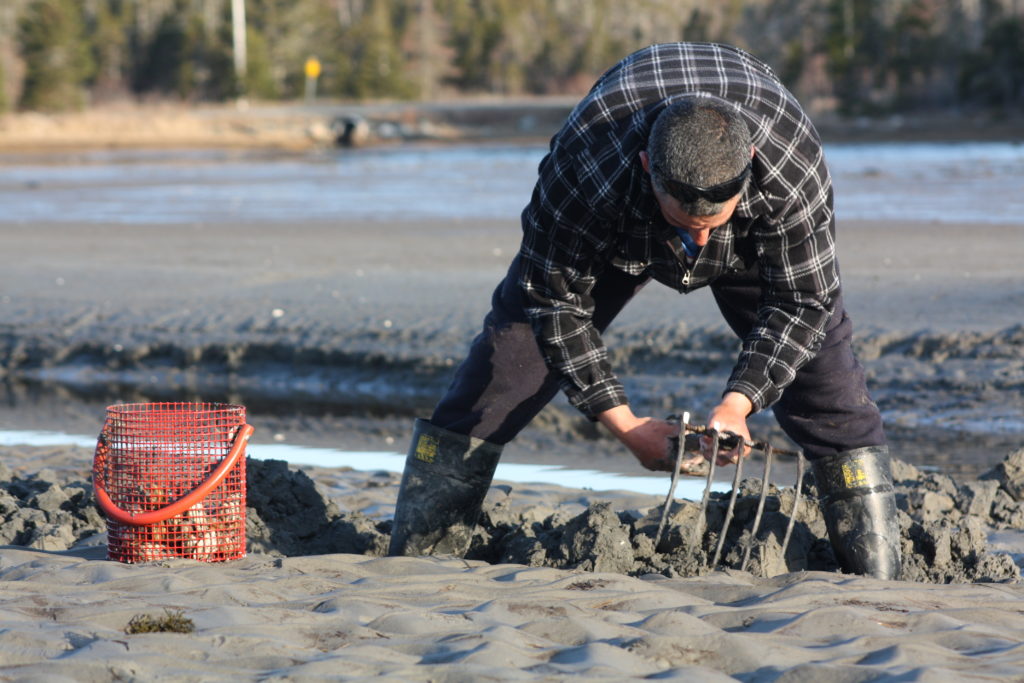
Clam digging in Nova Scotia (Photo: Memory Lane/Gordon Hammond)
12. Sip the most Canadian spirits you can think of
If you’ve ever ordered a Rye & Ginger, you were drinking something quintessentially Canadian. Canadian whisky is more than just whisky produced in Canada — historically, distillers were adding rye grain to get more flavour in their productions, giving it a distinct taste and colour. With more distilleries per capita than anywhere else in the country and awards at prestigious spirits competitions, Nova Scotia is quickly becoming a whisky and spirits powerhouse. From Glenora Distillery (13727 Route 19) in Cape Breton, purveyors of North America’s first single malt whisky, to maple vodka made with pure maple syrup at Steinhart Distillery (5963 NS-245) in Antigonish, Canadians are pushing boundaries and creating some of the best products with local ingredients.
13. See the ship immortalized on Canada’s dime
Nova Scotia boasts three UNESCO World Heritage Sites and two Biosphere reserves, ranking them alongside the Galapagos Islands and the Pyramids of Egypt. The quaint port town of Lunenberg is first on the list, designated a World Heritage Site for its unique seaside architecture — it’s the best example of a early British colonial settlement. Founded in 1753, the colonial design and maritime traditions have been maintained to the present day. Those visiting the town can explore the Fisheries Museum of the Atlantic (68 Bluenose Dr) or set sail on the Bluenose II, a replica of the fishing and racing schooner depicted on Canada’s 10-cent coin.
14. Witness the potential of cooperative sustainable development
The Bras d’Or Lake Biosphere Reserve, home to Mi’kmaq First Nations and descendants of early French, Scottish, and English settlers, was designated a UNESCO Biosphere reserve in 2011. Whether you charter a sailboat or paddle to Baddeck Bay, participate in a Mi’kmaq cultural journey, hike to Uisge Ban Falls, or join a Ceilidh at the Highland Village, you’ll be impressed with the way residents work in harmony with nature to promote a healthy environment, economy, and culture.
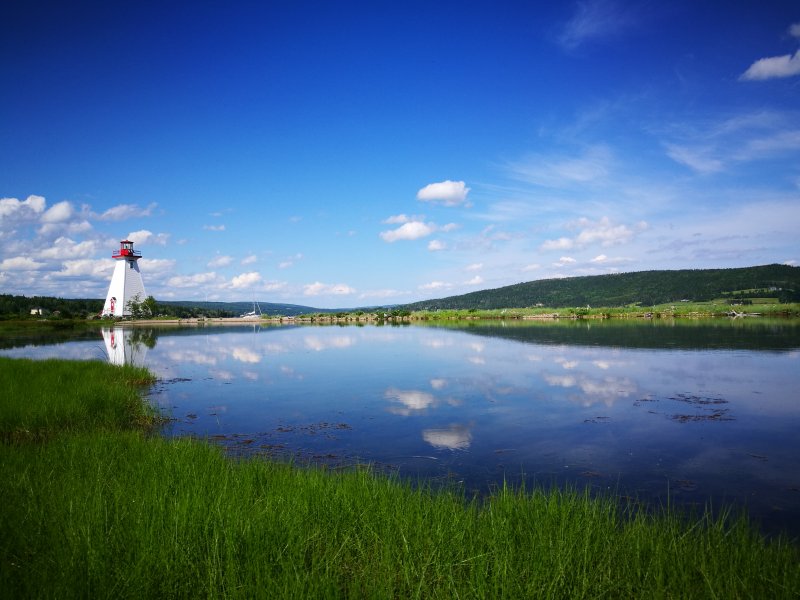
Kidston Island Lighthouse built in 1912 (Photo: Jim Foulds)
15. Hunt for 300 million year old fossils at Joggins Fossil Cliffs
The Joggins Fossil Cliffs have been drawing scientists and geologists for more than 150 years. Fossil records in this upper Bay of Fundy area date back to the Coal Age when the place was covered in the swamp forests that created coal deposits. It was selected as a UNESCO World Heritage Site because it’s the most complete record of life from the Carboniferous era in the world — plants, footprints, and ancestors of dinosaurs can all be found in these coastal cliffs. The local Fossil Centre organizes guided visits so you can learn more about this important evolutionary and geological monument that Charles Darwin called the “coal age Galápagos”.

Joggins Fossil Cliffs tell a 300-million-year-old story (Photo: Joggins Fossil Cliffs)
16. Shop at Canada’s longest running farmer’s market
Along Halifax’s waterfront is Canada’s longest continuously operating farmer’s market. Though it’s changed locations over the years, the Halifax Seaport Farmer’s Market has been selling seasonal fruits, vegetables, and other staples of the Canadian diet since 1750. Today, the market is home to 250 vendors who maintain the tradition of farm fresh foods and locally produced products. Spend the day chowing down on local goodies or pick up some tasty treats to take home.
1209 Marginal Road, B3H 4P7

Halifax Seaport Farmer’s Market (Photo: Halifax Seaport Farmers’ Market)
17. Drive along the Cabot Trail
Cabot Trail is a 300-kilometre loop along the coastline of Cape Breton Island and one of Canada’s most famous highways. With several exciting possibilities along the way, the journey itself is the destination. You’ll pass scenic lookout points, hiking trails, local artisan shops, and authentic seafood restaurants. The essential stop on Cabot Trail is the nine- kilometre Skyline Trail hike. You’ll roam part of Cape Breton Highlands National Park along cliff sides overlooking the Gulf of St. Lawrence. Keep an eye out for moose — one of Canada’s iconic fauna — whales, and bald eagles on the route. Spend a couple days in Cheticamp, a fishing village and French enclave with old gypsum mines turned natural turquoise pools.
18. Photograph the lighthouse at Peggy’s Cove
Peggy’s Point Lighthouse dates to 1914 and its position perched atop smooth rocks on the sea has made it one of the most photographed sites in the country. However, Peggy’s Cove is an old fishing village with more to offer than a photo op. Visit the Peggy of the Cove Museum (10235 Peggys Cove Rd) to find out just who Peggy was and then enjoy a bowl of chowder at a local seaside restaurant. Once you’ve filled up, head out on one of the nature trails where you’ll see dozens of inukshuks — traditional Inuit structures in the form of human figures built from stones. You might even try building one yourself!
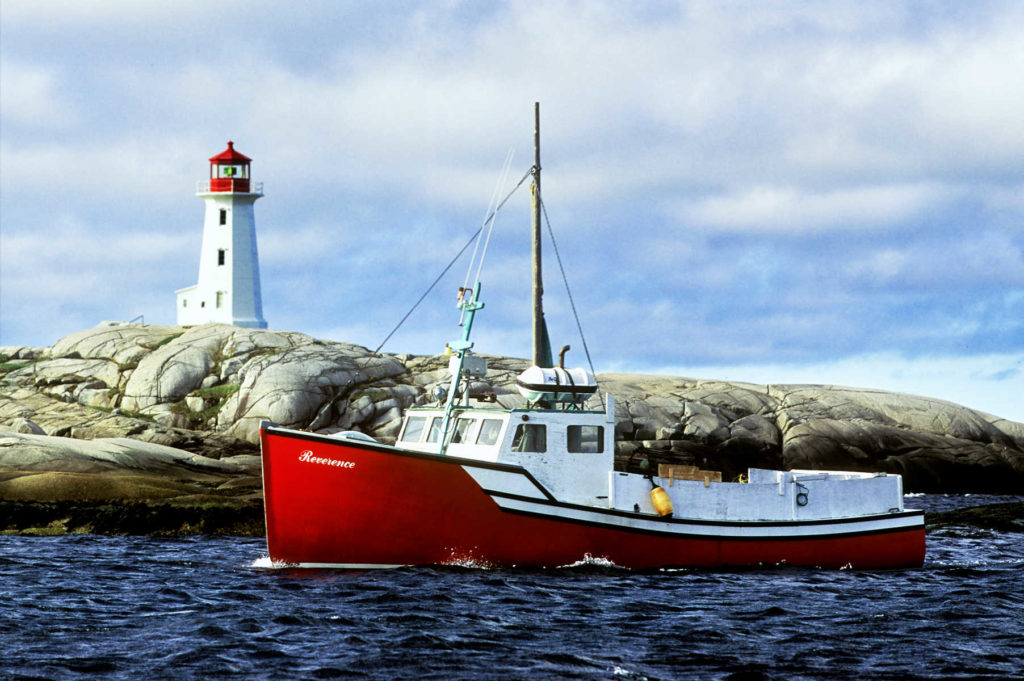
Reverence at Peggy’s Cove Lighthouse (Photo: Ivan Fraser)
19. Surf at Martinique Beach
The five kilometres of white sand at Martinique Beach make it Nova Scotia’s longest–and most beautiful. Thanks to its sheltered position and crescent shape, Martinique has clean and consistent waves that make it a popular surfing destination. If hanging ten isn’t quite your thing, Martinique Beach is part of a provincial park. Behind the sand dunes are wooded picnic areas where you can lounge seaside or look out for the variety of birds that frequent this wildlife refuge.
20. Take a shipwreck tour of Louisbourg
Visitors usually come to Louisbourg to visit the Fortress, a French stronghold founded in 1713. Twice the Fortress fell under seige to the British and was demolished in the 1760s. Two hundred years later, the fortress was rebuilt with streets, houses, and shops that depict life in the 18th century. Come summer, however, divers from around the world come to Nova Scotia to tour the harbours and shores of the province. Take a dive into Louisbourg’s military history by exploring the Prudent, Evelyn, or Le Celebre — three ships that lie at the bottom of the harbour off the coast.
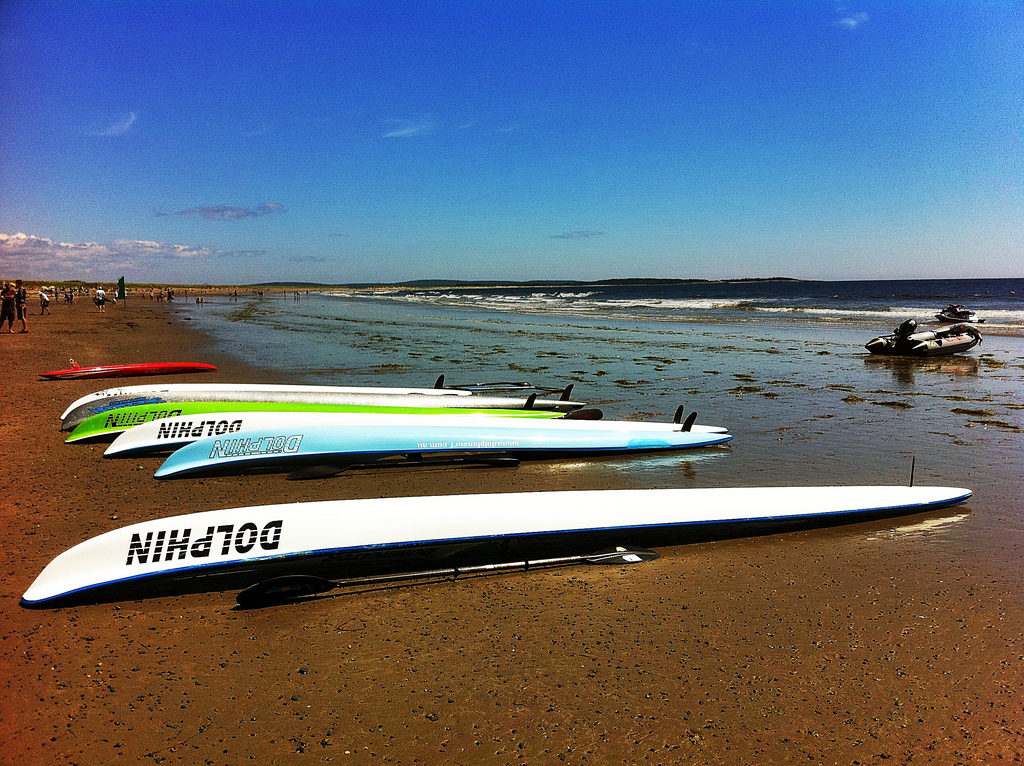
Dolphins on Martinique Beach, Nova Scotia (Photo: Jill /Blue Moonbeam Studio via Flickr)